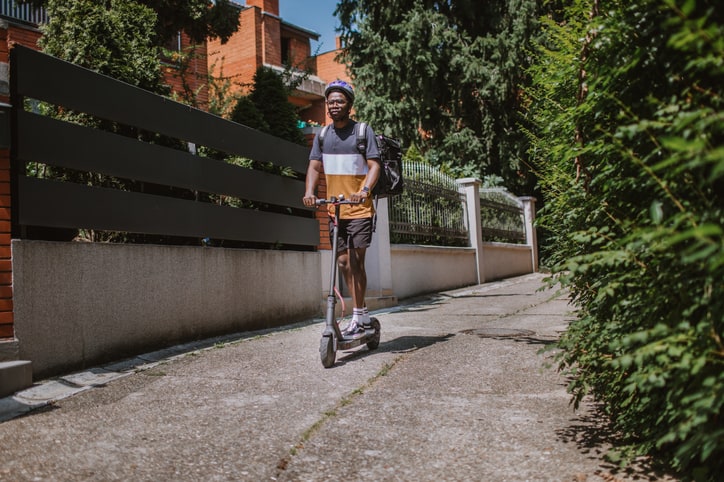When it comes to modern urban transport, Atlanta provides us with a perfect case study to inspect. With a vital mix of varying age demographics, income levels and interests, Atlantans balance openness to trying new modes of transportation in their beloved city with responsible riding practices that enhance overall rider community safety.
While many industries and economies may be struggling in the current uncertainty of a post-COVID world, micromobility is one that is positioned for potentially explosive growth – particularly in automobile-heavy, densely packed urban areas. Despite the wild ride of the past year, no other region is quite as perfectly primed for increased urban electric scooter usage as the peachiest of them all – Atlanta, Georgia.
Micromobility in Atlanta (By the Numbers)
We took to the data to evaluate this market on a deeper level. A recent Scoot Safe survey confirmed that 90 percent of Georgians surveyed are familiar with urban electric scooters and the emerging micromobility trend of scooter rentals across areas like the Atlanta BeltLine, Downtown, and Midtown. Many of these survey respondents are already familiar with scooter companies in Atlanta and the broader market – including names like Helbiz, Bird, Spin, and Lime. And an exciting tidbit – more than 60 percent of those surveyed said they had already previously rented an urban electric scooter! And with Atlantans always on the move, we are betting they’re open to going for another spin.
While 40 percent of Georgians surveyed had never ridden an urban electric scooter, they are likely to soon become familiar with this growing trend in their metro region. Coupled with some key market indicators for these different demographics, scooter rental companies in the Atlanta area are well-positioned for profitable growth and expansion in the coming years. More than 90 percent of survey respondents have access to a smartphone (iPhone, Android) or laptop computer, making them ideal for location-based retargeting campaigns designed to prompt that first – or next – ride around Atlanta.
Nearly 70 percent of those polled make $50,000 per year or less – markers of a population that is young (ages 16 to 35) and highly mobile. But these same markers point to some of Gen Z and Millennials’ most positive traits – risk aversion, openness to change, and a keen understanding of financial pressure that prompts them to seek out new, creative ways to get things done for less money. They’re online a lot and can be easily reached on popular social media platforms like TikTok, Instagram, Facebook, and YouTube. They embrace fun and freedom, but after multiple unprecedented events (hello, 2020), they understand mitigating risk and the vital nature of basic safety. These Atlantans represent the ideal profitable market for engaging with new and exciting modes of transportation throughout the metro Atlanta area.
There’s another unexpected market for increased urban scooter rentals here, and it may just surprise you. What if the next eScooter growth generation consists of higher income individuals, now well-positioned to take a much-needed break from adulthood? These are the former kids who remember landlines and beepers – and they’re primed for a vacation from life’s stress. There’s truly no better group for a throwback to buzzing around their old-school neighborhoods than mobile, family-minded older Millennials and Gen X’ers. Once the last generation of “latchkey” kids, today they are active professionals and parents, looking for new ways to comfortably experience adventure in their own community – often alongside their dynamic and busy families. When you break down the current market in the metro Atlanta area, times are ideal for unparalleled growth in the urban electric scooter rental landscape – and consumers here are ready.
The Benefits of Micromobility
Atlanta’s ideal cityscape presents value to scooter rental companies in one other key way, which other metro areas can emulate – quick thinking and common-sense measures that maximize safety across ridership communities. Now a year into its Action Plan for Safer Streets, Atlanta has a growing wealth of protected bike lanes and light individual transportation routes. These pathways protect the integrity of devices and investments companies make to enter the market. Making safe riding easy positively influences the decision to ride for new or inexperienced customers.
While the Atlanta Police Department employs practices to encourage safe ridership, Atlanta is also letting infrastructure improvements mitigate much of the traffic flow and other logistics. This means riders can enjoy their experience, while law enforcement doesn’t have to do much hand-holding to manage rider safety. There are some policies already in place that restrict ridership times during low-traffic hours, when incidents like drunk driving and other problematic behaviors present the most risk for companies and consumers. Atlantans are smart, savvy, and have local investments that are helping make the daily experience of ridership a more secure and comfortable mode of transport.
In a city known for its traffic and drawl, urbanite Georgians are taking a fresh step outdoors, looking for new roads to travel, getting a little wind in the hair, and getting to their next stop safely.
Head over to our resource library for tools, research, and assets that will help you make micromobility even safer in Georgia.


